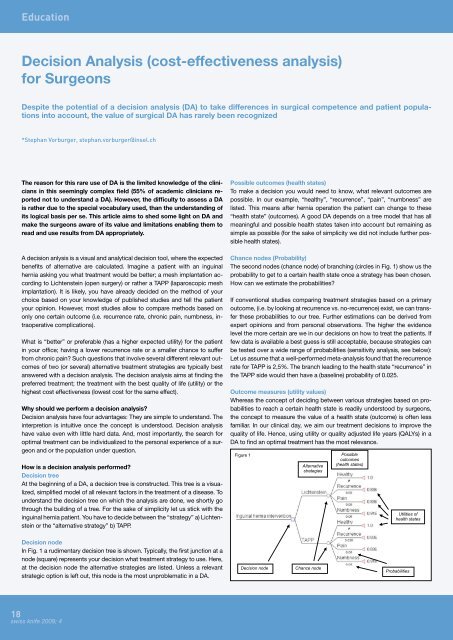Kodieren oder kapitulieren - SWISS KNIFE
Kodieren oder kapitulieren - SWISS KNIFE
Kodieren oder kapitulieren - SWISS KNIFE
Erfolgreiche ePaper selbst erstellen
Machen Sie aus Ihren PDF Publikationen ein blätterbares Flipbook mit unserer einzigartigen Google optimierten e-Paper Software.
18<br />
Education<br />
Decision Analysis (cost-effectiveness analysis)<br />
for Surgeons<br />
Despite the potential of a decision analysis (DA) to take differences in surgical competence and patient populations<br />
into account, the value of surgical DA has rarely been recognized<br />
*Stephan Vorburger, stephan.vorburger@insel.ch<br />
The reason for this rare use of DA is the limited knowledge of the clinicians<br />
in this seemingly complex field (55% of academic clinicians reported<br />
not to understand a DA). However, the difficulty to assess a DA<br />
is rather due to the special vocabulary used, than the understanding of<br />
its logical basis per se. This article aims to shed some light on DA and<br />
make the surgeons aware of its value and limitations enabling them to<br />
read and use results from DA appropriately.<br />
A decision anlysis is a visual and analytical decision tool, where the expected<br />
benefits of alternative are calculated. Imagine a patient with an inguinal<br />
hernia asking you what treatment would be better; a mesh implantation according<br />
to Lichtenstein (open surgery) or rather a TAPP (laparoscopic mesh<br />
implantation). It is likely, you have already decided on the method of your<br />
choice based on your knowledge of published studies and tell the patient<br />
your opinion. However, most studies allow to compare methods based on<br />
only one certain outcome (i.e. recurrence rate, chronic pain, numbness, intraoperative<br />
complications).<br />
What is “better” or preferable (has a higher expected utility) for the patient<br />
in your office; having a lower recurrence rate or a smaller chance to suffer<br />
from chronic pain? Such questions that involve several different relevant outcomes<br />
of two (or several) alternative treatment strategies are typically best<br />
answered with a decision analysis. The decision analysis aims at finding the<br />
preferred treatment; the treatment with the best quality of life (utility) or the<br />
highest cost effectiveness (lowest cost for the same effect).<br />
Why should we perform a decision analysis?<br />
Decision analysis have four advantages: They are simple to understand. The<br />
interpretion is intuitive once the concept is understood. Decision analysis<br />
have value even with little hard data. And, most importantly, the search for<br />
optimal treatment can be individualized to the personal experience of a surgeon<br />
and or the population under question.<br />
How is a decision analysis performed?<br />
Decision tree<br />
At the beginning of a DA, a decision tree is constructed. This tree is a visualized,<br />
simplified model of all relevant factors in the treatment of a disease. To<br />
understand the decision tree on which the analysis are done, we shortly go<br />
through the building of a tree. For the sake of simplicity let us stick with the<br />
inguinal hernia patient. You have to decide between the “strategy” a) Lichtenstein<br />
or the “alternative strategy” b) TAPP.<br />
Decision node<br />
In Fig. 1 a rudimentary decision tree is shown. Typically, the first junction at a<br />
node (square) represents your decision what treatment strategy to use. Here,<br />
at the decision node the alternative strategies are listed. Unless a relevant<br />
strategic option is left out, this node is the most unproblematic in a DA.<br />
swiss knife 2009; 4<br />
Possible outcomes (health states)<br />
To make a decision you would need to know, what relevant outcomes are<br />
possible. In our example, “healthy”, “recurrence”, “pain”, “numbness” are<br />
listed. This means after hernia operation the patient can change to these<br />
“health state” (outcomes). A good DA depends on a tree model that has all<br />
meaningful and possible health states taken into account but remaining as<br />
simple as possible (for the sake of simplicity we did not include further possible<br />
health states).<br />
Chance nodes (Probability)<br />
The second nodes (chance node) of branching (circles in Fig. 1) show us the<br />
probability to get to a certain health state once a strategy has been chosen.<br />
How can we estimate the probabilities?<br />
If conventional studies comparing treatment strategies based on a primary<br />
outcome, (i.e. by looking at recurrence vs. no-recurrence) exist, we can transfer<br />
these probabilities to our tree. Further estimations can be derived from<br />
expert opinions and from personal observations. The higher the evidence<br />
level the more certain are we in our decisions on how to treat the patients. If<br />
few data is available a best guess is still acceptable, because strategies can<br />
be tested over a wide range of probabilities (sensitivity analysis, see below):<br />
Let us assume that a well-performed meta-analysis found that the recurrence<br />
rate for TAPP is 2,5%. The branch leading to the health state “recurrence” in<br />
the TAPP side would then have a (baseline) probability of 0.025.<br />
Outcome measures (utility values)<br />
Whereas the concept of deciding between various strategies based on probabilities<br />
to reach a certain health state is readily understood by surgeons,<br />
the concept to measure the value of a health state (outcome) is often less<br />
familiar. In our clinical day, we aim our treatment decisions to improve the<br />
quality of life. Hence, using utility or quality adjusted life years (QALYs) in a<br />
DA to find an optimal treatment has the most relevance.<br />
Figure 1<br />
Alternative<br />
strategies<br />
Decision node Chance node<br />
Possible<br />
outcomes<br />
(health states)<br />
Utilities of<br />
health states<br />
Probabilities
















